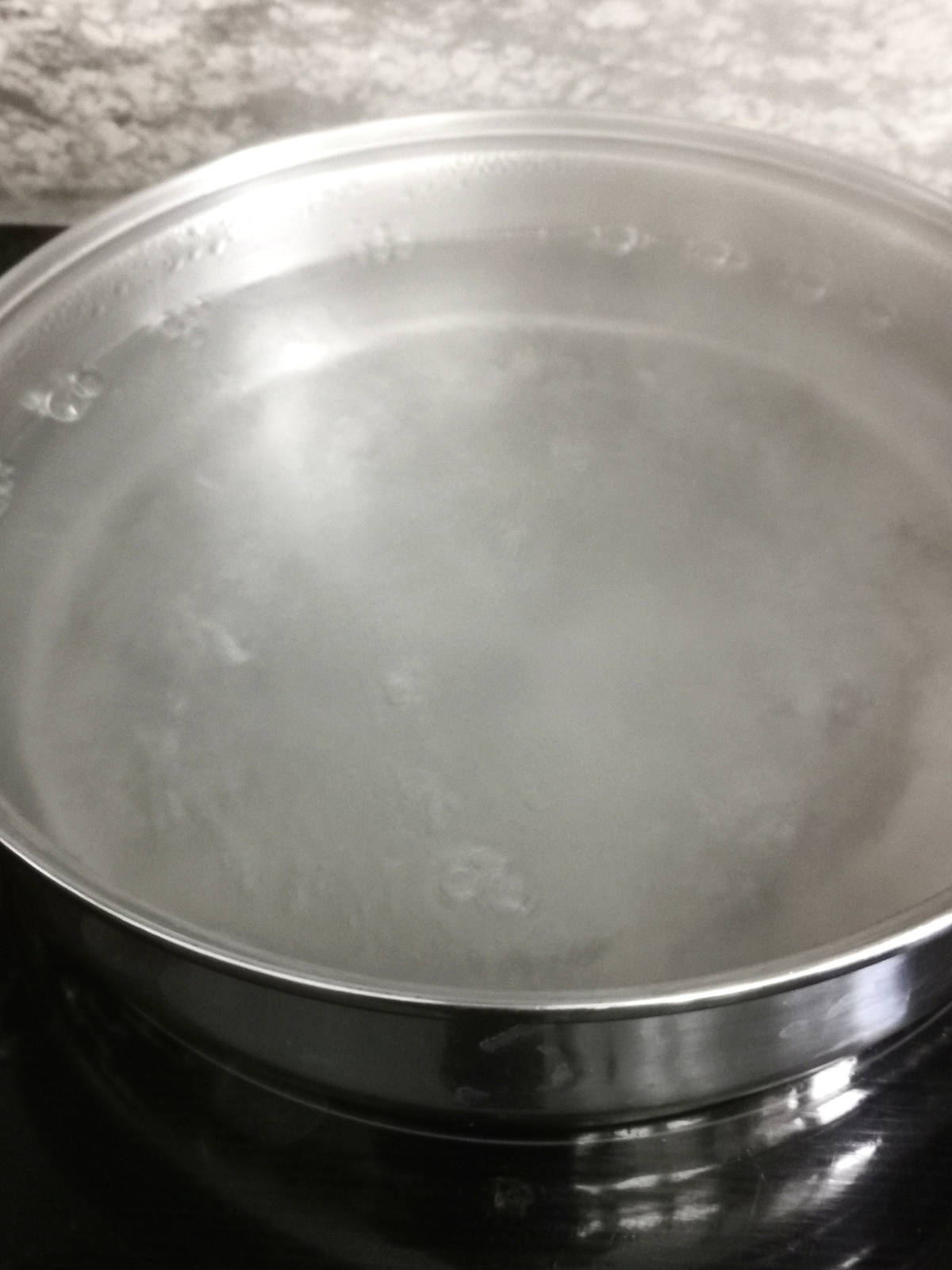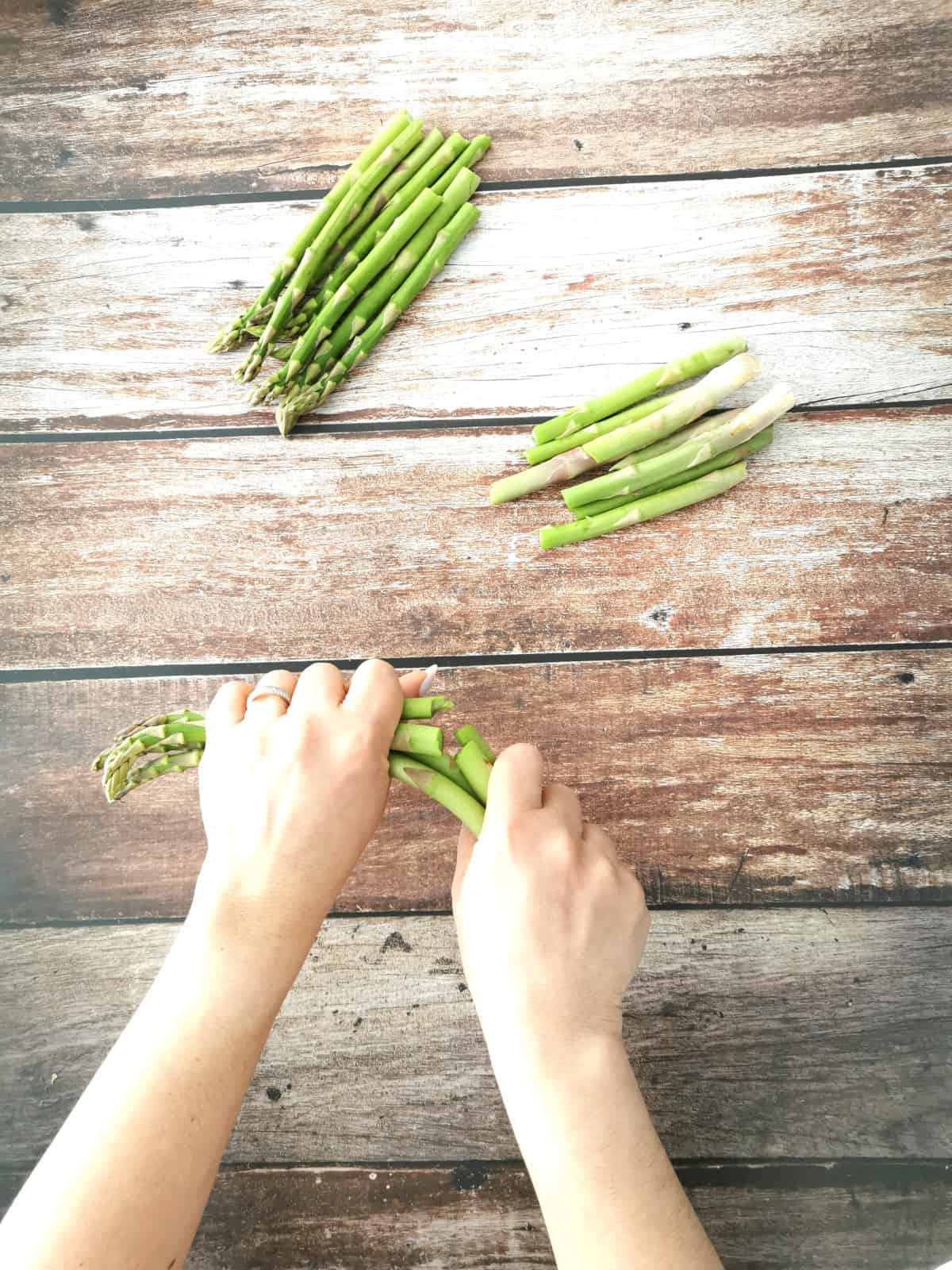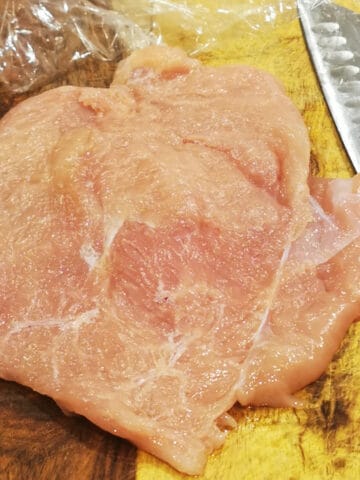Blanching asparagus is an easy way to make it more tender and keep its vibrant green color. It involves boiling the asparagus briefly and then quickly cooling it in ice water. This helps the asparagus stay crisp and preserve its nutritional value. In this How To Blanch Perfect Asparagus guide, we'll take you through the steps to achieve perfectly blanched asparagus, a versatile side dish for various meals.

Whether you're eating asparagus on its own, as a light snack, or in a dish, such as our Asparagus and Mango Salad Recipe or this Asparagus in Smoked Salmon and Cucumber appetizer, you'll enjoy the freshness, subtle earthiness, and crunch it adds, not to mention the ton of health benefits. It's rich in essential nutrients such as vitamin K, vitamin C, vitamin A, and folate.
Jump to:
Reasons to blanch asparagus
- Preserve Vibrant Color: Blanching helps maintain the bright green color of asparagus.
- Enhances Texture: The blanching process results in a tender-crisp texture.
- Reduces Bitterness: Blanching can help reduce the bitterness often associated with asparagus, creating a milder flavor profile.
- Retains Nutritional Value: The short cooking time in boiling water helps retain the nutritional content of asparagus, including vitamins and minerals.
- Prevents Overcooking: Blanching allows for precise control over the cooking time, preventing the asparagus from becoming mushy or overcooked.
Types of asparagus
These are the three most common types of asparagus:
- Green Asparagus: This is the most common and widely available type of asparagus. It has a vibrant green color and is known for its fresh, grassy flavor. Green asparagus is typically what you find in grocery stores and is versatile for various dishes. Our post concentrates mostly on green asparagus.
- White Asparagus: grown by keeping the spears covered with soil or other materials, preventing exposure to sunlight. This lack of sunlight prevents chlorophyll production, giving the asparagus a pale or ivory color. White asparagus has a milder flavor compared to green asparagus and is a delicacy in some cuisines.
- Purple Asparagus: it has vibrant purple hues on the outside and a green interior. It has a slightly sweeter flavor compared to green asparagus. The purple color is due to the presence of anthocyanins, which are antioxidants.
How to choose asparagus
When choosing the most common, green, asparagus look for ones with a vibrant green color. The shade may vary slightly but make sure to avoid dull or yellowish asparagus. Also, avoid asparagus that feels limp or wilted. Check the tips of the asparagus spears. They should be tightly closed and compact, without signs of flowering or spreading. Open or feathery tips may indicate older asparagus.
Thin asparagus is generally more tender, while thicker spears may have a heartier texture. The thickness of the asparagus is up to you, just try to purchase similar thickness pieces so they cook evenly.
How to blanch asparagus
STEP 1: Boil Water

Fill a large pot with water and bring it to a boil. You can add a teaspoon of salt to the boiling water for seasoning, but this is optional, depending on whether you will be eating the asparagus on its own or adding it to a recipe.
STEP 2: Prepare asparagus

Meanwhile, rinse the asparagus under cold water, then trim the tough ends by snapping them off or cutting them with a knife. The asparagus will naturally break where the tough part ends.
STEP 3: Blanch

Once the water is boiling, carefully add the asparagus spears. Make sure the water covers the asparagus completely. Boil the asparagus for about 2-3 minutes. The exact time will depend on the thickness of the asparagus. The goal is to slightly cook the asparagus while keeping it crisp and vibrant.
STEP 4: Prepare an ice bath

While the asparagus is boiling, fill a large bowl with ice and cold water. This will be used to quickly cool down the asparagus and stop the cooking process. See frequently asked questions below if you don't have ice for an ice bath.
STEP 5: Shock in ice water

Using tongs or a slotted spoon, transfer the blanched asparagus directly from the boiling water to the ice water bath. Allow the asparagus to sit in the ice water for 2-3 minutes.
STEP 6: Drain and Pat Dry

Once the asparagus is cooled, remove it from the ice water bath and place it on a clean kitchen towel or paper towel to drain excess water and pat it dry.
Top tips
- Select asparagus with uniform thickness, especially if you plan to cook them together. This ensures even cooking.
- Use a wide and deep pot to allow the asparagus to be fully submerged in boiling water without overcrowding. This ensures even cooking.
- If blanching a large quantity, work in smaller batches to prevent overcrowding and ensure all the asparagus cooks evenly.
- Use enough water to maintain a rolling boil.
- Test a spear for doneness during the blanching process. It should be tender but still have a slight crunch. Be careful not to overcook.
- Don't skip patting the asparagus dry. Excess water can dilute flavors and affect the texture.
Frequently Asked Questions
Asparagus spears have a natural breaking point where the tender part meets the tougher, fibrous end. By gently bending or snapping the spear near the base, it will break naturally at this point. Snapping asparagus stalks will remove the tough, fibrous ends and ensure that you cook only the tender parts of the asparagus.
Yes, you can cut it into smaller pieces before blanching. It is a common practice, especially if you plan to use it in salads, stir-fries, or other dishes where you need cut-up asparagus. Just make sure to cut the asparagus into even pieces. This ensures uniform cooking.
If you don't have ice for an ice bath, you can fill a large bowl with very cold water and submerge the blanched asparagus in the water immediately after removing it from the boiling water. You can also run cold water over the blanched asparagus in a colander or under the tap. Just make sure that the water is as cold as possible. Gently toss or move the asparagus around in the running water to cool them down evenly. The key is to reduce the temperature quickly to prevent overcooking and to preserve the color and texture of the asparagus.
You can reheat the asparagus in the microwave, the oven, or on the stovetop in a little bit of water. You can also saute them in a non-stick pan with a little bit of oil. Grilling them is also a tasty option! Whichever method you are using, try adding a dash of salt, pepper, or a drizzle of olive oil before reheating for extra flavor.
When reheating in the microwave or oven, covering the asparagus can help retain moisture and prevent drying out. Be careful not to overheat the asparagus, because it can lead to a mushy texture. Check for doneness frequently, especially when using shorter reheating times.
Yes, you can freeze asparagus after cooking, and in fact, blanching is a common method used before freezing to help preserve its color, texture, and nutritional value. Place the blanched asparagus into airtight freezer bags or vacuum-sealed bags. Ensure that you remove as much air as possible to prevent freezer burn. It's best to use it within 8-12 months. When you're ready to use the frozen asparagus, there's no need to thaw them. You can cook them directly from frozen.
Serving suggestions
Blanched asparagus can be served immediately or if you're not using it right away, you can store it in the refrigerator for later use.
Serve it on its own (as a snack), with a little dipping sauce, or as a side dish. It's great on the side with some Oven Roasted Potato Cubes and Stir-Fried Chicken Thighs or Pan Seared Salmon with Vegetables.
Cut up the blanched asparagus and add the pieces to this Cherry Tomato and Asparagus Salad or this Asparagus and Mango Salad Recipe.
Other how-to guides
If you tried this How To Blanch Perfect Asparagus guide or any other guide or recipe on my website, please leave a 🌟 star rating and let me know how it went in the 📝 comments below. Thanks for visiting!
Recipe

How To Blanch Perfect Asparagus
Equipment
- 1 deep pan
- 1 tongs
Ingredients
- 1.5 pounds asparagus
- water just enough to submerge the asparagus
- salt to taste, optional
Instructions
- Fill a large pot with water and bring it to a boil. You can add a teaspoon of salt to the boiling water for seasoning, but this is optional, depending on whether you will be eating the asparagus on its own or adding it to a recipe.
- Meanwhile, rinse the asparagus under cold water, then trim the tough ends by snapping them off or cutting them with a knife. The asparagus will naturally break where the tough part ends.
- Once the water is boiling, carefully add the asparagus spears. Make sure the water covers the asparagus completely. Boil the asparagus for about 2-3 minutes. The exact time will depend on the thickness of the asparagus. The goal is to slightly cook the asparagus while keeping it crisp and vibrant.
- While the asparagus is boiling, fill a large bowl with ice and cold water. This will be used to quickly cool down the asparagus and stop the cooking process. If you don't have ice, see the last note in notes section below.
- Using tongs, transfer the blanched asparagus directly from the boiling water to the ice water bath. Allow the asparagus to sit in the ice water for 2-3 minutes.
- Once the asparagus is cooled, remove it from the ice water bath and place it on a clean kitchen towel or paper towel to drain excess water and pat it dry.
- The asparagus can be served immediately or if you're not using it right away, you can store it in the refrigerator for later use.
Notes
- Select asparagus with uniform thickness, especially if you plan to cook them together. This ensures even cooking.
- Use a wide and deep pot to allow the asparagus to be fully submerged in boiling water without overcrowding. This ensures even cooking.
- If blanching a large quantity, work in smaller batches to prevent overcrowding and ensure all the asparagus cooks evenly.
- Use enough water to maintain a rolling boil.
- Test a spear for doneness during the blanching process. It should be tender but still have a slight crunch. Be careful not to overcook.
- Don't skip patting the asparagus dry. Excess water can dilute flavors and affect the texture.
- If you don't have ice for an ice bath, you can fill a large bowl with very cold water and submerge the blanched asparagus in the water immediately after removing it from the boiling water. You can also run cold water over the blanched asparagus in a colander or under the tap. Just make sure that the water is as cold as possible. Gently toss or move the asparagus around in the running water to cool them down evenly. The key is to reduce the temperature quickly to prevent overcooking and to preserve the color and texture of the asparagus.





Comments
No Comments